Case Study on PLC: Revolutionizing Industrial Automation Systems
VerifiedAdded on 2023/06/15
|11
|2179
|341
Report
AI Summary
This report examines the significant role of Programmable Logic Controllers (PLCs) in modern industrial automation. It begins by highlighting the challenges faced by non-automated organizations, emphasizing issues related to data management, human error, and sustainability. The report then introduces PLC as a crucial control system, detailing its components and functionalities, illustrating how it automates processes by monitoring inputs and controlling devices in real-time. The advantages of PLC are thoroughly discussed, including fast decision-making, fault diagnosis, flexibility, reliability, and cost-efficiency. The report also addresses the limitations of PLC, such as the need for skilled operators, potential malfunctions at extreme temperatures, and space constraints due to wiring. It concludes that PLC is essential for industries aiming to achieve sustainability and competitive advantage through automation, despite certain challenges, and has a vast scope for future development.
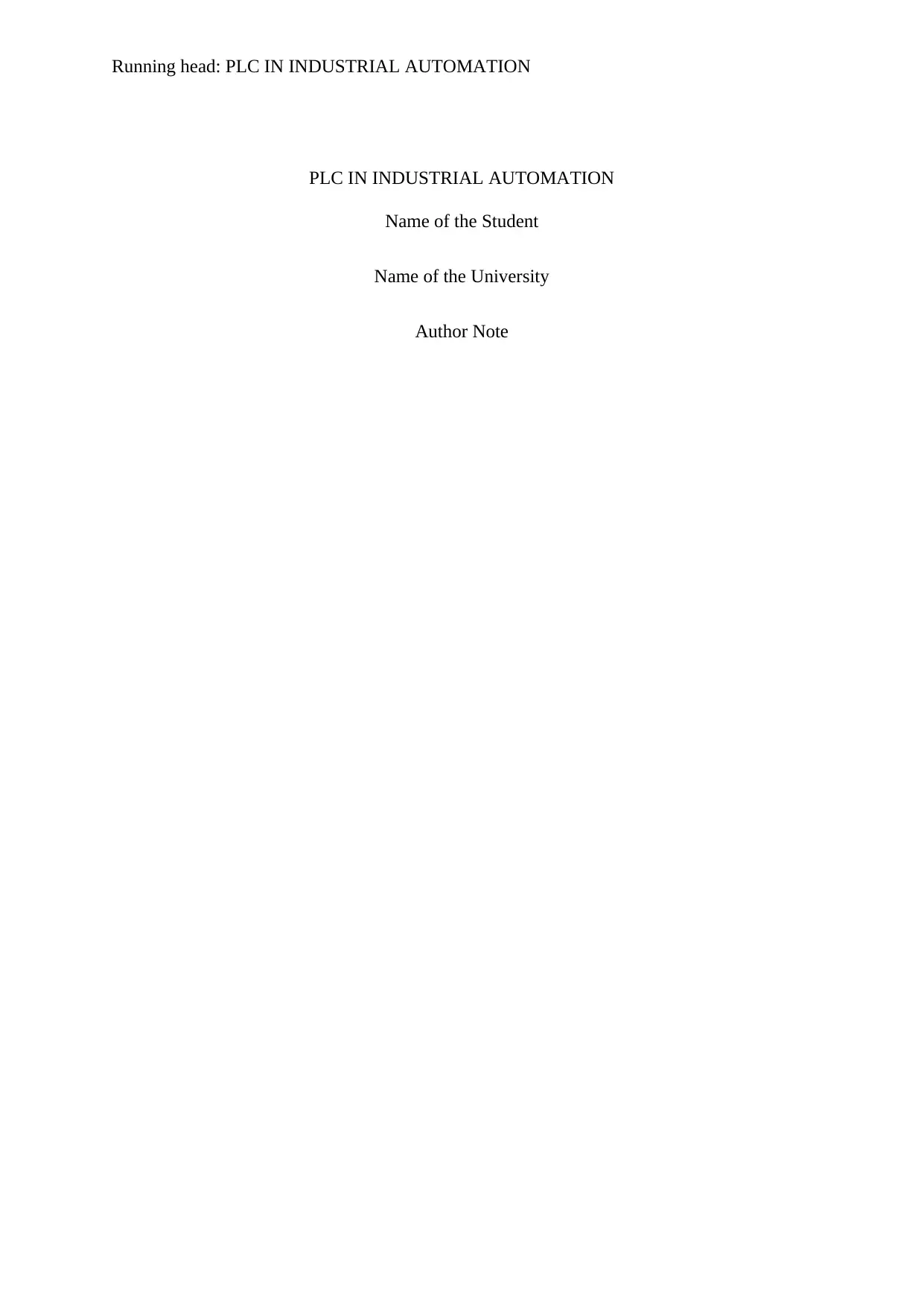
Running head: PLC IN INDUSTRIAL AUTOMATION
PLC IN INDUSTRIAL AUTOMATION
Name of the Student
Name of the University
Author Note
PLC IN INDUSTRIAL AUTOMATION
Name of the Student
Name of the University
Author Note
Paraphrase This Document
Need a fresh take? Get an instant paraphrase of this document with our AI Paraphraser

1PLC IN INDUSTRIAL AUTOMATION
Executive Summary:
PLC is playing a significant role in the industrial automation, and the devised paper has
attempted at evaluating that role. The paper has also listed the advantage of the discussed
system and offered an insight at the limitation. Appropriate referencing to increase reliability
and diagrams to enhance the understanding of the subject has been used. The paper has been
summarised to conclude the paper.
Executive Summary:
PLC is playing a significant role in the industrial automation, and the devised paper has
attempted at evaluating that role. The paper has also listed the advantage of the discussed
system and offered an insight at the limitation. Appropriate referencing to increase reliability
and diagrams to enhance the understanding of the subject has been used. The paper has been
summarised to conclude the paper.
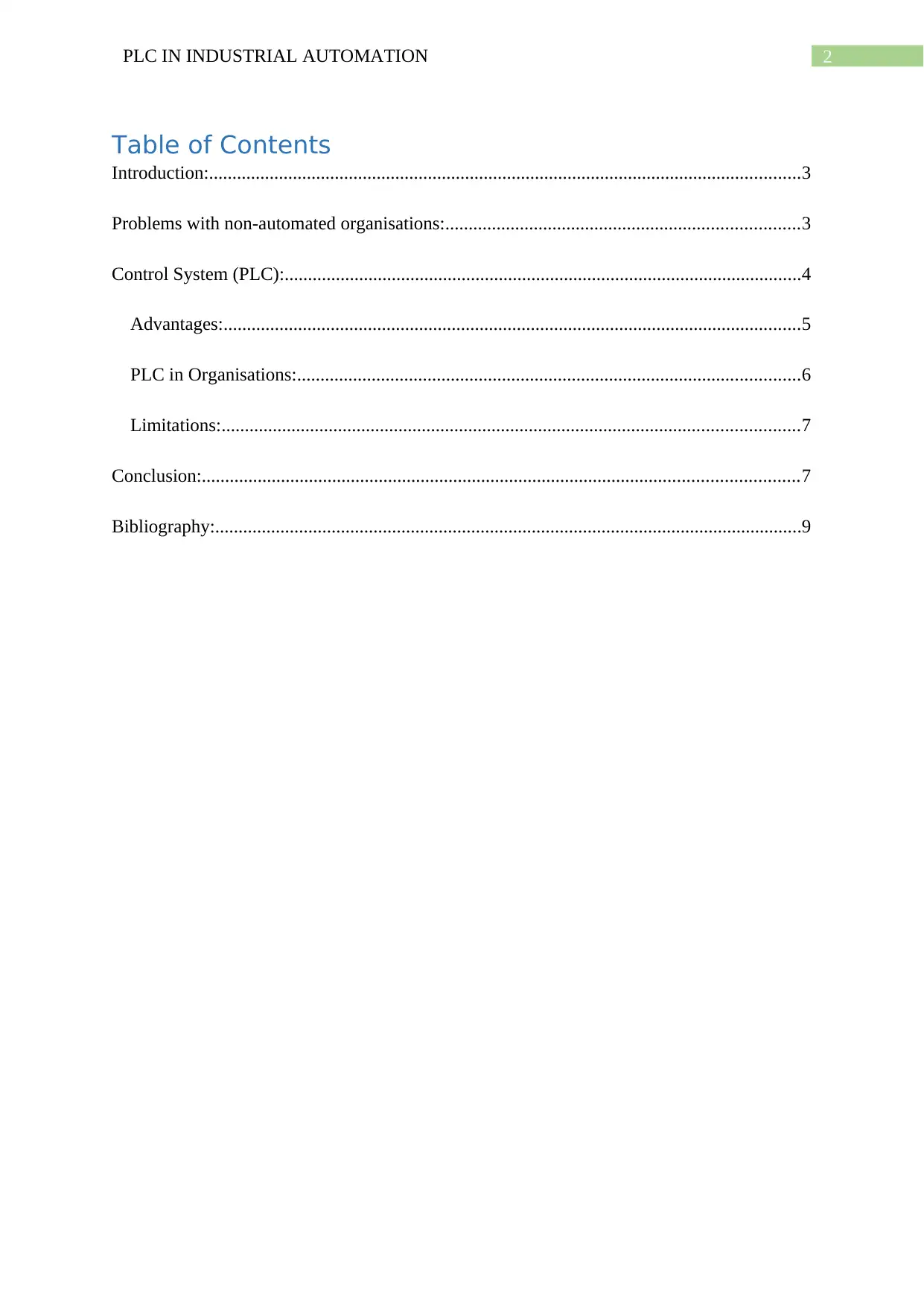
2PLC IN INDUSTRIAL AUTOMATION
Table of Contents
Introduction:...............................................................................................................................3
Problems with non-automated organisations:............................................................................3
Control System (PLC):...............................................................................................................4
Advantages:............................................................................................................................5
PLC in Organisations:............................................................................................................6
Limitations:............................................................................................................................7
Conclusion:................................................................................................................................7
Bibliography:..............................................................................................................................9
Table of Contents
Introduction:...............................................................................................................................3
Problems with non-automated organisations:............................................................................3
Control System (PLC):...............................................................................................................4
Advantages:............................................................................................................................5
PLC in Organisations:............................................................................................................6
Limitations:............................................................................................................................7
Conclusion:................................................................................................................................7
Bibliography:..............................................................................................................................9
⊘ This is a preview!⊘
Do you want full access?
Subscribe today to unlock all pages.

Trusted by 1+ million students worldwide

3PLC IN INDUSTRIAL AUTOMATION
Introduction:
Automation has emerged as one of the favourite industrial factors and the reason
behind it, is the operational ease, cost-efficiency and other significant benefits offered by the
former. However, implementing and managing automation is not straightforward in an
organisation. Hence, a system known as the PLC (Programmer Logic Controller) was
designed to assist the organisations in achieving automation. The devised paper will offer an
insight into the matter “PLC in Industrial Automation”. It will offer an idea of the problems
that the organisations faced and how the subject (PLC) can be assistance for the
organisations. Post-conclusion, the paper will provide appropriate references to the collected
data to enhance the reliability of the stated data.
Problems with non-automated organisations:
Fig
ure 1: Problems with non-automated organisations
(Source: Created by Author)
Non-automated
operations
Data
management
Paper works can
be complexed
and time
consuming
Paper can get
detoriated,
risking loss of
data
Vulnreable to
physical damage,
fire or other
calamities
product/service
management
Human errors
can detoriate the
offerings quality
Human errors
can increase
organisational
expenditure.
Employee
management
Scheduling shifts
for the
employees
Keeping track of
the employee
productivity.
Sustainability
Bad quality
offering can ruin
organisation's
goodwill
Improper use of
organisational
resources effects
sustainability
Introduction:
Automation has emerged as one of the favourite industrial factors and the reason
behind it, is the operational ease, cost-efficiency and other significant benefits offered by the
former. However, implementing and managing automation is not straightforward in an
organisation. Hence, a system known as the PLC (Programmer Logic Controller) was
designed to assist the organisations in achieving automation. The devised paper will offer an
insight into the matter “PLC in Industrial Automation”. It will offer an idea of the problems
that the organisations faced and how the subject (PLC) can be assistance for the
organisations. Post-conclusion, the paper will provide appropriate references to the collected
data to enhance the reliability of the stated data.
Problems with non-automated organisations:
Fig
ure 1: Problems with non-automated organisations
(Source: Created by Author)
Non-automated
operations
Data
management
Paper works can
be complexed
and time
consuming
Paper can get
detoriated,
risking loss of
data
Vulnreable to
physical damage,
fire or other
calamities
product/service
management
Human errors
can detoriate the
offerings quality
Human errors
can increase
organisational
expenditure.
Employee
management
Scheduling shifts
for the
employees
Keeping track of
the employee
productivity.
Sustainability
Bad quality
offering can ruin
organisation's
goodwill
Improper use of
organisational
resources effects
sustainability
Paraphrase This Document
Need a fresh take? Get an instant paraphrase of this document with our AI Paraphraser
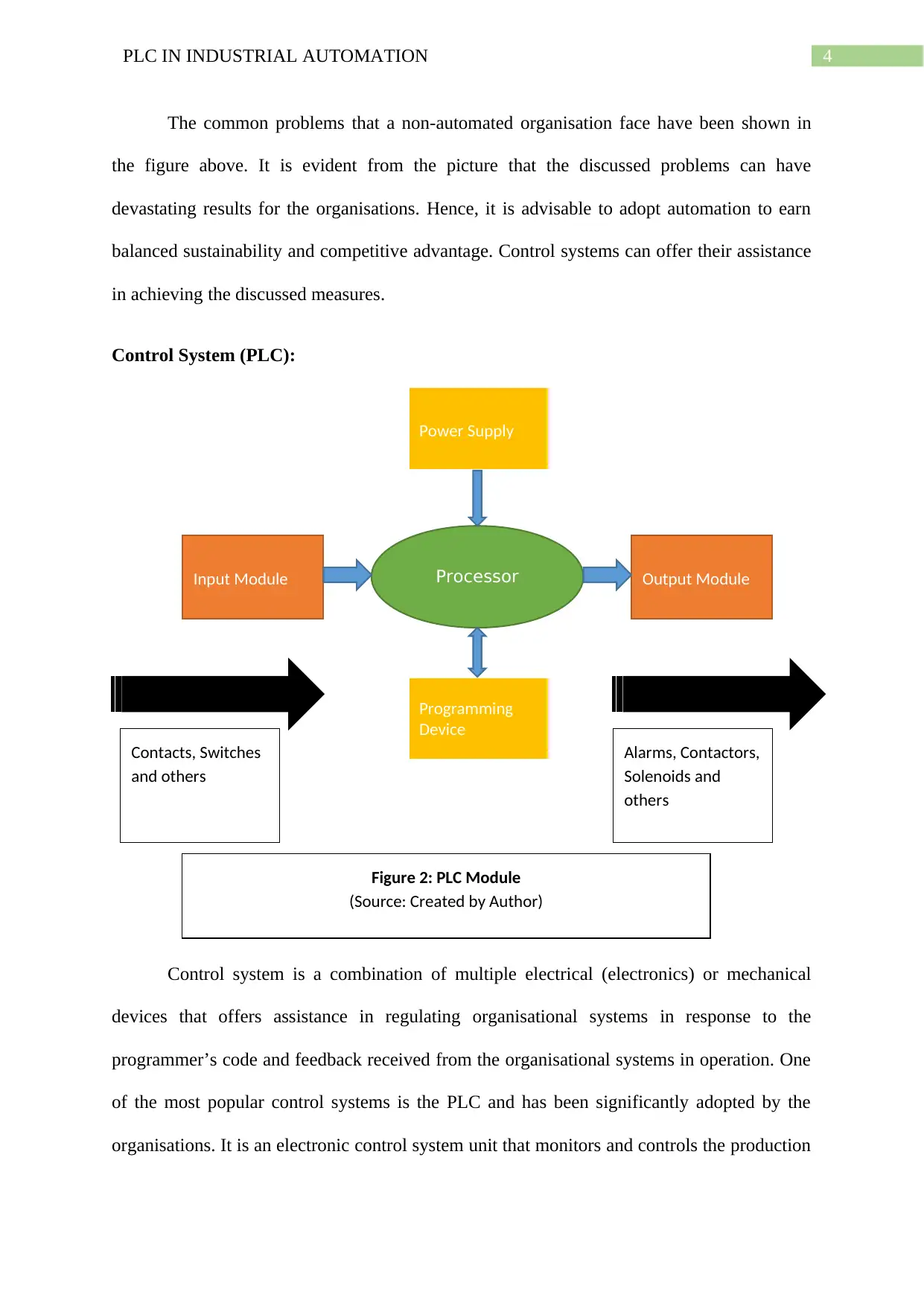
4PLC IN INDUSTRIAL AUTOMATION
The common problems that a non-automated organisation face have been shown in
the figure above. It is evident from the picture that the discussed problems can have
devastating results for the organisations. Hence, it is advisable to adopt automation to earn
balanced sustainability and competitive advantage. Control systems can offer their assistance
in achieving the discussed measures.
Control System (PLC):
Control system is a combination of multiple electrical (electronics) or mechanical
devices that offers assistance in regulating organisational systems in response to the
programmer’s code and feedback received from the organisational systems in operation. One
of the most popular control systems is the PLC and has been significantly adopted by the
organisations. It is an electronic control system unit that monitors and controls the production
ProcessorInput Module Output Module
Power Supply
Programming
Device
Contacts, Switches
and others
Alarms, Contactors,
Solenoids and
others
Figure 2: PLC Module
(Source: Created by Author)
The common problems that a non-automated organisation face have been shown in
the figure above. It is evident from the picture that the discussed problems can have
devastating results for the organisations. Hence, it is advisable to adopt automation to earn
balanced sustainability and competitive advantage. Control systems can offer their assistance
in achieving the discussed measures.
Control System (PLC):
Control system is a combination of multiple electrical (electronics) or mechanical
devices that offers assistance in regulating organisational systems in response to the
programmer’s code and feedback received from the organisational systems in operation. One
of the most popular control systems is the PLC and has been significantly adopted by the
organisations. It is an electronic control system unit that monitors and controls the production
ProcessorInput Module Output Module
Power Supply
Programming
Device
Contacts, Switches
and others
Alarms, Contactors,
Solenoids and
others
Figure 2: PLC Module
(Source: Created by Author)

5PLC IN INDUSTRIAL AUTOMATION
processes and the building systems. The discussed system is designed to perform only a
single set of operations. However, it is notable that the tasks are carried out in real-time
constraints and with high reliability and performance. The systems are designed to be robust
and comes with the capability of withstanding the harsh industrial environment that includes
high temperature, vibrations, electrical noise and humidity.
The image above shows the rough module of the PLC along with its major
components. It is evident from the diagram that PLC is an industrial computing system that
monitors the inputs for the organisation devices and based on the findings the decisions in
accordance with its programming. The decision is then transferred to the organisational
devices to make then work according to the needs. Applying the PLC in the organisation
makes the systems automated, and the human effort is only limited to the implementation of
the technology and in dire situations.
Advantages:
The deemed system offers significant benefits in an organisation, the core benefits
offered by the deemed system has been listed as follows:
I. Fast and accurate decision making according to the organisational needs.
II. The system also has the capability of identifying and diagnosing the faults in the
organisational system and hence, offering the advantage of sorting out the fault in-
time before it causes any significant damage.
III. The programming of the system can be changed to change the role and working of the
system, in other words, the discussed system offers flexibility.
IV. The discussed system offers reliability and also costs less in operational stage. The
reason for the stated fact lays on the fact that the system lacks any moving part and
hence, it saves power and have a long life.
processes and the building systems. The discussed system is designed to perform only a
single set of operations. However, it is notable that the tasks are carried out in real-time
constraints and with high reliability and performance. The systems are designed to be robust
and comes with the capability of withstanding the harsh industrial environment that includes
high temperature, vibrations, electrical noise and humidity.
The image above shows the rough module of the PLC along with its major
components. It is evident from the diagram that PLC is an industrial computing system that
monitors the inputs for the organisation devices and based on the findings the decisions in
accordance with its programming. The decision is then transferred to the organisational
devices to make then work according to the needs. Applying the PLC in the organisation
makes the systems automated, and the human effort is only limited to the implementation of
the technology and in dire situations.
Advantages:
The deemed system offers significant benefits in an organisation, the core benefits
offered by the deemed system has been listed as follows:
I. Fast and accurate decision making according to the organisational needs.
II. The system also has the capability of identifying and diagnosing the faults in the
organisational system and hence, offering the advantage of sorting out the fault in-
time before it causes any significant damage.
III. The programming of the system can be changed to change the role and working of the
system, in other words, the discussed system offers flexibility.
IV. The discussed system offers reliability and also costs less in operational stage. The
reason for the stated fact lays on the fact that the system lacks any moving part and
hence, it saves power and have a long life.
⊘ This is a preview!⊘
Do you want full access?
Subscribe today to unlock all pages.

Trusted by 1+ million students worldwide

6PLC IN INDUSTRIAL AUTOMATION
V. The modular assembling of the system also makes its maintenance easy and cost-
efficient.
VI. Some organisational operations are too complicated for the humans to attain a 100%
result from those operations. However, those operations can be easily handled with
the assistance of the PLC and in the process ensuring organisational devices are kept
operationalise.
VII. One of the significant concerns that the organisations face before implementing a new
system in the organisation is cost and effort invested in installation. PLC also stands
fit for this demand of the organisation because the coupling process with the
organisational systems is simple hence minimising the effort and omits the cost
involved with buying new organisational equipment.
VIII. The use of analog signal and ‘closed loop control programming’ enhances the security
of the system from the cyberattacks or any remote attack on the organisation.
IX. Counters, timers and comparators can be programmed to do scheduling of the tasks
and enable comparative decision making.
X. The functionality and usability of the system are also straightforward because the
deemed system contains advisory system and colourographic.
PLC in Organisations:
An article published by the wiseguysreports.com suggests that the PLC market is
about to see a significant surge in the year domain of 2018-2025 and may get a boost of up to
$156.8 billion. The figures are derived from the industry professionals who are associated
with the PLC systems and are witnessing the advantage offered by the subject. Another
forecasting on the subject cites the changes that PLC will offer in the different industries and
the image below show the stats.
V. The modular assembling of the system also makes its maintenance easy and cost-
efficient.
VI. Some organisational operations are too complicated for the humans to attain a 100%
result from those operations. However, those operations can be easily handled with
the assistance of the PLC and in the process ensuring organisational devices are kept
operationalise.
VII. One of the significant concerns that the organisations face before implementing a new
system in the organisation is cost and effort invested in installation. PLC also stands
fit for this demand of the organisation because the coupling process with the
organisational systems is simple hence minimising the effort and omits the cost
involved with buying new organisational equipment.
VIII. The use of analog signal and ‘closed loop control programming’ enhances the security
of the system from the cyberattacks or any remote attack on the organisation.
IX. Counters, timers and comparators can be programmed to do scheduling of the tasks
and enable comparative decision making.
X. The functionality and usability of the system are also straightforward because the
deemed system contains advisory system and colourographic.
PLC in Organisations:
An article published by the wiseguysreports.com suggests that the PLC market is
about to see a significant surge in the year domain of 2018-2025 and may get a boost of up to
$156.8 billion. The figures are derived from the industry professionals who are associated
with the PLC systems and are witnessing the advantage offered by the subject. Another
forecasting on the subject cites the changes that PLC will offer in the different industries and
the image below show the stats.
Paraphrase This Document
Need a fresh take? Get an instant paraphrase of this document with our AI Paraphraser
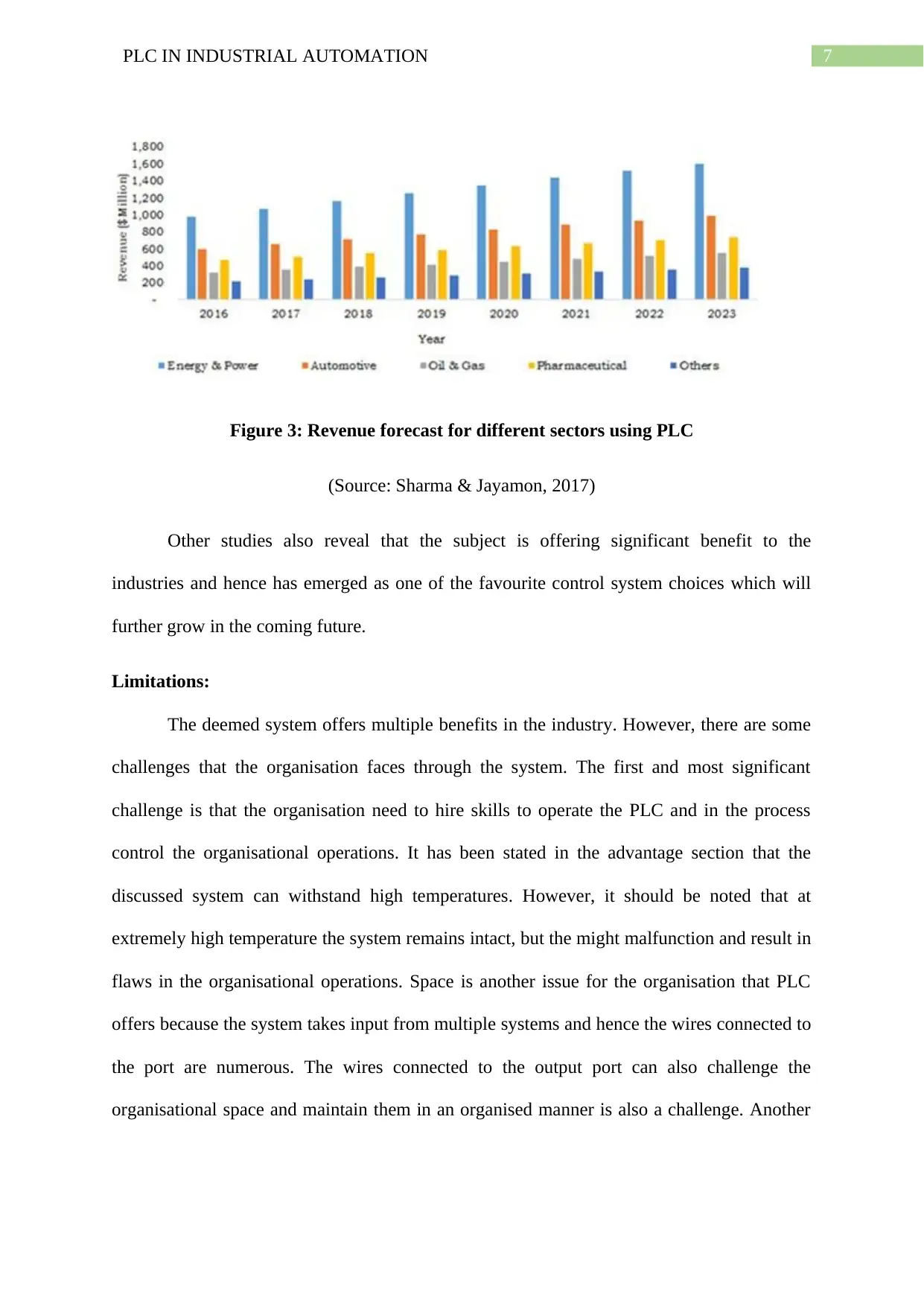
7PLC IN INDUSTRIAL AUTOMATION
Figure 3: Revenue forecast for different sectors using PLC
(Source: Sharma & Jayamon, 2017)
Other studies also reveal that the subject is offering significant benefit to the
industries and hence has emerged as one of the favourite control system choices which will
further grow in the coming future.
Limitations:
The deemed system offers multiple benefits in the industry. However, there are some
challenges that the organisation faces through the system. The first and most significant
challenge is that the organisation need to hire skills to operate the PLC and in the process
control the organisational operations. It has been stated in the advantage section that the
discussed system can withstand high temperatures. However, it should be noted that at
extremely high temperature the system remains intact, but the might malfunction and result in
flaws in the organisational operations. Space is another issue for the organisation that PLC
offers because the system takes input from multiple systems and hence the wires connected to
the port are numerous. The wires connected to the output port can also challenge the
organisational space and maintain them in an organised manner is also a challenge. Another
Figure 3: Revenue forecast for different sectors using PLC
(Source: Sharma & Jayamon, 2017)
Other studies also reveal that the subject is offering significant benefit to the
industries and hence has emerged as one of the favourite control system choices which will
further grow in the coming future.
Limitations:
The deemed system offers multiple benefits in the industry. However, there are some
challenges that the organisation faces through the system. The first and most significant
challenge is that the organisation need to hire skills to operate the PLC and in the process
control the organisational operations. It has been stated in the advantage section that the
discussed system can withstand high temperatures. However, it should be noted that at
extremely high temperature the system remains intact, but the might malfunction and result in
flaws in the organisational operations. Space is another issue for the organisation that PLC
offers because the system takes input from multiple systems and hence the wires connected to
the port are numerous. The wires connected to the output port can also challenge the
organisational space and maintain them in an organised manner is also a challenge. Another
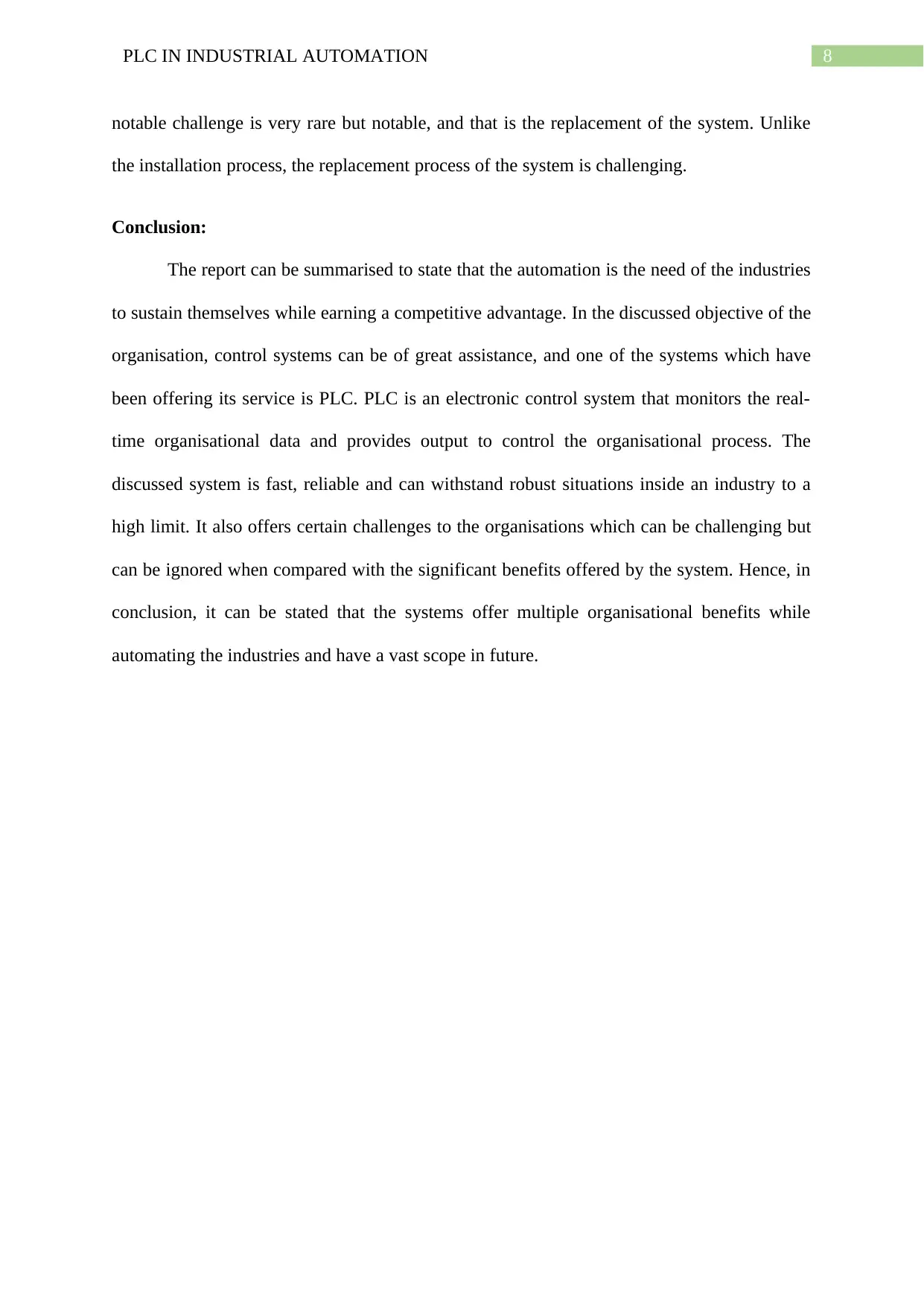
8PLC IN INDUSTRIAL AUTOMATION
notable challenge is very rare but notable, and that is the replacement of the system. Unlike
the installation process, the replacement process of the system is challenging.
Conclusion:
The report can be summarised to state that the automation is the need of the industries
to sustain themselves while earning a competitive advantage. In the discussed objective of the
organisation, control systems can be of great assistance, and one of the systems which have
been offering its service is PLC. PLC is an electronic control system that monitors the real-
time organisational data and provides output to control the organisational process. The
discussed system is fast, reliable and can withstand robust situations inside an industry to a
high limit. It also offers certain challenges to the organisations which can be challenging but
can be ignored when compared with the significant benefits offered by the system. Hence, in
conclusion, it can be stated that the systems offer multiple organisational benefits while
automating the industries and have a vast scope in future.
notable challenge is very rare but notable, and that is the replacement of the system. Unlike
the installation process, the replacement process of the system is challenging.
Conclusion:
The report can be summarised to state that the automation is the need of the industries
to sustain themselves while earning a competitive advantage. In the discussed objective of the
organisation, control systems can be of great assistance, and one of the systems which have
been offering its service is PLC. PLC is an electronic control system that monitors the real-
time organisational data and provides output to control the organisational process. The
discussed system is fast, reliable and can withstand robust situations inside an industry to a
high limit. It also offers certain challenges to the organisations which can be challenging but
can be ignored when compared with the significant benefits offered by the system. Hence, in
conclusion, it can be stated that the systems offer multiple organisational benefits while
automating the industries and have a vast scope in future.
⊘ This is a preview!⊘
Do you want full access?
Subscribe today to unlock all pages.

Trusted by 1+ million students worldwide

9PLC IN INDUSTRIAL AUTOMATION
Bibliography:
Alphonsus, E. R., & Abdullah, M. O. (2016). A review on the applications of programmable
logic controllers (PLCs). Renewable and Sustainable Energy Reviews, 60, 1185-1205.
Basile, F., Chiacchio, P., & Gerbasio, D. (2013). On the implementation of industrial
automation systems based on PLC. IEEE Transactions on Automation Science and
Engineering, 10(4), 990-1003.
Basnight, Z., Butts, J., Lopez Jr, J., & Dube, T. (2013). Firmware modification attacks on
programmable logic controllers. International Journal of Critical Infrastructure
Protection, 6(2), 76-84.
Besada-Portas, E., Lopez-Orozco, J. A., de la Torre, L., & Jesus, M. (2013). Remote control
laboratory using ejs applets and twincat programmable logic controllers. IEEE
Transactions on Education, 56(2), 156-164.
Gaj, P., Jasperneite, J., & Felser, M. (2013). Computer communication within industrial
distributed environment—A survey. IEEE Transactions on Industrial
Informatics, 9(1), 182-189.
Galloway, B., & Hancke, G. P. (2013). Introduction to industrial control networks. IEEE
Communications Surveys and Tutorials, 15(2), 860-880.
Global Programmable Logic Controllers (PLC) Market by Architecture, Product, Industry
Vertical and Region 2014-2025: Segment Analysis, Trend Forecast and Business
Strategy– WiseGuyReports. (2016). Wiseguyreports.com. Retrieved 6 April 2018,
from https://www.wiseguyreports.com/reports/3051104-global-programmable-logic-
controllers-plc-market-by-architecture
Bibliography:
Alphonsus, E. R., & Abdullah, M. O. (2016). A review on the applications of programmable
logic controllers (PLCs). Renewable and Sustainable Energy Reviews, 60, 1185-1205.
Basile, F., Chiacchio, P., & Gerbasio, D. (2013). On the implementation of industrial
automation systems based on PLC. IEEE Transactions on Automation Science and
Engineering, 10(4), 990-1003.
Basnight, Z., Butts, J., Lopez Jr, J., & Dube, T. (2013). Firmware modification attacks on
programmable logic controllers. International Journal of Critical Infrastructure
Protection, 6(2), 76-84.
Besada-Portas, E., Lopez-Orozco, J. A., de la Torre, L., & Jesus, M. (2013). Remote control
laboratory using ejs applets and twincat programmable logic controllers. IEEE
Transactions on Education, 56(2), 156-164.
Gaj, P., Jasperneite, J., & Felser, M. (2013). Computer communication within industrial
distributed environment—A survey. IEEE Transactions on Industrial
Informatics, 9(1), 182-189.
Galloway, B., & Hancke, G. P. (2013). Introduction to industrial control networks. IEEE
Communications Surveys and Tutorials, 15(2), 860-880.
Global Programmable Logic Controllers (PLC) Market by Architecture, Product, Industry
Vertical and Region 2014-2025: Segment Analysis, Trend Forecast and Business
Strategy– WiseGuyReports. (2016). Wiseguyreports.com. Retrieved 6 April 2018,
from https://www.wiseguyreports.com/reports/3051104-global-programmable-logic-
controllers-plc-market-by-architecture
Paraphrase This Document
Need a fresh take? Get an instant paraphrase of this document with our AI Paraphraser

10PLC IN INDUSTRIAL AUTOMATION
Kiran, A. R., Sundeep, B. V., Vardhan, C. S., & Mathews, N. (2013). The principle of
programmable logic controller and its role in automation. International Journal of
Engineering Trends and Technology, 4(3), 500-502.
Knapp, E. D., & Langill, J. T. (2014). Industrial Network Security: Securing critical
infrastructure networks for smart grid, SCADA, and other Industrial Control Systems.
Syngress.
Lashin, M. M. (2014). Different applications of programmable logic controller
(PLC). International Journal of Computer Science, Engineering and Information
Technology (IJCSEIT), 4(1), 27-32.
Patel, T., Sheth, S., & Patel, P. (2015). Design of semi-automatic hydraulic blanking machine
using PLC. In National Conference on Innovative & Emerging Technologies (NCIET-
2015) (pp. 410-412).
Schütz, D., Wannagat, A., Legat, C., & Vogel-Heuser, B. (2013). Development of PLC-based
software for increasing the dependability of production automation systems. IEEE
Transactions on Industrial Informatics, 9(4), 2397-2406.
Sharma, K., & Jayamon, J. (2017). Nano Programmable Logic Controller (PLC) Market by
Component (Processor, Power Supply, and Input/Output), Service (Training,
Maintenance, and Consulting), Type (Fixed Nano PLC and Modular Nano PLC), and
Industry Vertical (Energy & Power, Automotive, Oil & Gas, Pharmaceutical, and
Others) - Global Opportunity Analysis and Industry Forecast, 2017-2023. Allied
Market Research. Retrieved 6 April 2018, from
https://www.alliedmarketresearch.com/nano-programmable-logic-controller-PLC-
marke
Kiran, A. R., Sundeep, B. V., Vardhan, C. S., & Mathews, N. (2013). The principle of
programmable logic controller and its role in automation. International Journal of
Engineering Trends and Technology, 4(3), 500-502.
Knapp, E. D., & Langill, J. T. (2014). Industrial Network Security: Securing critical
infrastructure networks for smart grid, SCADA, and other Industrial Control Systems.
Syngress.
Lashin, M. M. (2014). Different applications of programmable logic controller
(PLC). International Journal of Computer Science, Engineering and Information
Technology (IJCSEIT), 4(1), 27-32.
Patel, T., Sheth, S., & Patel, P. (2015). Design of semi-automatic hydraulic blanking machine
using PLC. In National Conference on Innovative & Emerging Technologies (NCIET-
2015) (pp. 410-412).
Schütz, D., Wannagat, A., Legat, C., & Vogel-Heuser, B. (2013). Development of PLC-based
software for increasing the dependability of production automation systems. IEEE
Transactions on Industrial Informatics, 9(4), 2397-2406.
Sharma, K., & Jayamon, J. (2017). Nano Programmable Logic Controller (PLC) Market by
Component (Processor, Power Supply, and Input/Output), Service (Training,
Maintenance, and Consulting), Type (Fixed Nano PLC and Modular Nano PLC), and
Industry Vertical (Energy & Power, Automotive, Oil & Gas, Pharmaceutical, and
Others) - Global Opportunity Analysis and Industry Forecast, 2017-2023. Allied
Market Research. Retrieved 6 April 2018, from
https://www.alliedmarketresearch.com/nano-programmable-logic-controller-PLC-
marke
1 out of 11
Related Documents
Your All-in-One AI-Powered Toolkit for Academic Success.
+13062052269
info@desklib.com
Available 24*7 on WhatsApp / Email
![[object Object]](/_next/static/media/star-bottom.7253800d.svg)
Unlock your academic potential
Copyright © 2020–2025 A2Z Services. All Rights Reserved. Developed and managed by ZUCOL.





